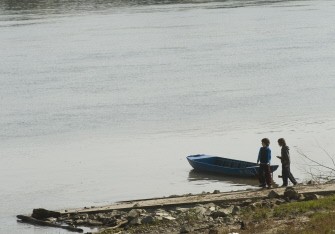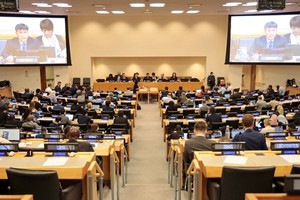KOLONTAR, Hungary, Oct 10, 2010 (AFP) - Hungary raced against time Sunday to erect a dam around a ruptured reservoir and divert a new wave of toxic sludge that threatens to overwhelm already devastated villages.
As hundreds of volunteers joined engineers rushing to erect the 600-metre dam, a top official said it was only a matter of days before the reservoir housing a chemical residue would begin to crumble.

"In two or three days there is going to be rain and we are trying to speed things up so that we can finish off the dam before the rain comes," Zoltan Illes, the state secretary for environmental protection, told reporters at the dam construction site.
"Once the rain is here, the remaining sludge will be washed out and the dam's northern section is going to break away. This is imminent. Once the wall breaks down, the sludge will start flowing again."
Repair work also continued on the reservoir itself where cracks have been detected, raising fears that what is already Hungary's worst environmental disaster could soon get even worse.
At least seven people were killed when the red-coloured sludge first began seeping from the reservoir next to an alumina plant before then cascading into nearby villages and tributaries of the Danube.
Kolontar was the village worst hit by the disaster and its entire population of nearly 1,000 people have been forced to evacuate while the threat of a new spill remains.
Many have been put up in a sports centre in the nearby town of Ajka although others have moved in with relatives.
Tibor Dobson, the official in charge of the disaster relief effort, said around 800 volunteers were helping 900 police, disaster relief workers and firefighters Sunday.
The country's public health service said all relief workers must wear breathing masks and protective glasses, as drying sludge was starting to produce dust.
"The red sludge, if it drys, can be inhaled and could irritate the mucous membrane, and irritant effects may damage the skin and eyes," the service said in a statement.
A team of five experts from the European Union's civil protection unit are heading to Hungary to assess the environmental impact and issue advice on decontamination.
Half a dozen cranes and a similar number of bulldozers were at the site of the dam on Sunday, as part of the effort to build a dam which will eventually be up to five metres in height and six metres in width once completed.
"I am not a disaster tourist," said local man Gyorgy Racz, who had come to inspect the damage. "I'm doing the community a favour by seeing everything with my own eyes."
Illes said that around 2.5 million tonnes of sludge still remain inside the reservoir after around 800,000 tonnes spilled out.
But he said that the remaining sludge should be easier to deal with if it does spill out.
"This is a different texture now, more like clay and not going to flow as far," he told reporters.
More than 40 people who suffered injuries from the spill were still in hospital Sunday, most treated for burns from the chemicals which also killed livestock and fish.
"They don't have life-threatening injuries, but some will need plastic surgery," said Jeno Racz, director of the Veszprem county hospital.
A three-year-old boy was also transferred to a Budapest hospital because some of the sludge had entered his eyes, causing serious damage, Racz said.
Villagers evacuated to Ajka, 160 kilometres (100 miles) from the capital Budapest, were worried about their homes.
"Unfortunately we will have to stay here for a couple of nights until they build that dam. After that we can hopefully return," said Peter, who like all of those who spent the night at the shelter would only give his first name.
The sludge from the MAL Hungarian Aluminium Production and Trade Company plant is a residue from aluminium production that contains toxic heavy metals such as lead, cadmium, arsenic and chromium.






)

















